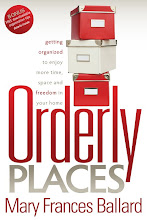Somewhere in cyberspace are the organizing tips for October. They did not appear as they should have when I signed in today. Perhaps they will appear as they were scheduled but just in case, I will post them again at the end of this post. It would be good to check over it if you are planning any special holiday meals.
On to November!
With such a dramatic weather event to end this October, it
is hard to get in gear for the winter holidays that are just around the
corner. Inevitably they will come and
planning ahead will make the tasks much easier.
Here are several reminders plus strategies for getting your kitchen
ready for the holidays.
To begin the kitchen organizing, spend some time going
through the kitchen equipment. Now is a
good time to donate or sell those pots, pans, small appliances, tools and
utensils you do not use. If you have not
used an item in the past year, it should not be taking up valuable real estate
in your kitchen. Consider storing it in
a more remote place in the house if you cannot part with it.
Inventory the pantry.
If yours is normally full it will be difficult to add the special
holiday items you need this time of the year.
Check the expiration dates on spices and some staple items you have not
used in a long time. Eliminate or use
immediately all you can to make more storage space.
To organize it, use the trays, containers, turntables,
and/or racks to help you group items in the same category together. Keep items you use everyday in the most
convenient spaces. Small boxes,
envelopes or packages should be grouped in clear containers so they are not
lost on the shelving and can be easily accessed. If shelving is deep, use
baskets or trays to hold items so they can be pulled forward to access items in
the back. Finally, try to leave a few
inches of empty space between categories of food on the shelves. This allows room for new items and also gives
an appearance of order.
Make a list of what your holiday recipes require and what
you will need during the next few weeks.
Some special seasonal items will disappear from the grocery shelves
before the holidays so shopping for those now will be advantageous. Check off all ingredients you already have so
you do not duplicate items that will take up valuable shelving.
Keep records of all you holiday planning, meals, events and
reminders for future holidays. It will
make planning for next year so much easier.
I have a folder (on my computer) with the menus, grocery lists, guest
lists, etc. that I update every year. I
print those out, take notes on the printed copies and then update my original
files.
Have packages for mailing out of town ready to send. Some overseas deadlines occur in
November. Even packages to domestic
locations should be ready to ship by the end of the month.
Now is the best time for online shopping. Almost all stores are offering free shipping
and the selection is better now than later.
Be sure to save receipts until after the holiday so items can be returned
if necessary and to validate any charges on future credit statements. It is a good idea to keep these in a special
envelope, folder, box, basket, etc. designated only for them.
Last month we reminded you to purchase holiday cards if you
are particular about them. Now is the
time to address and get them ready to mail.
Email greetings can wait until December.
And I can never stress this point enough: If you choose to send a holiday newsletter,
remember to keep it short and sweet. The
shorter, the sweeter. No bragging is
allowed; keep it newsy with love and appreciation for the input the recipients
have had in your lives.
If you begin your holiday decorating early, be selective as
you pull out the boxes of decorations.
Pass on those items that you no longer like or use to save space and
time. Permanent wreaths for the door can
have the bow and a few leaves or flowers changed each season and will not have
to be packed and stored. I purchase
inexpensive wreath decorations for my permanent vine wreath each season and
toss them after use. They are normally
dirty or faded anyway.
Stand alone decorations specific to the holidays take lots
of time in packing and unpacking each year and require more storage space. By simply adding decorative bows, etc. to
lamps, candles, house plants, etc., you can make your home festive without
needing extra storage bins and space after the holidays.
As I have advised every year, avoid shopping on Black Friday
unless you absolutely must go and be sure to stick to your “needs” list. Going into the stores with their displays of
special pricing, etc. is an emotional trap waiting for your hard earned
cash. And all that stuff you don’t
really need will clutter your house.
After years of getting up before dawn to hit the sales, I
have learned it is much smarter to just stay home that weekend, get more sleep and
decorate.
If you love the adventure, if
you only buy what you need and is on your list, and if you don’t mind crowds
and insane traffic jams and parking, go for it and send me your stories!
maryfrances@OrderlyPlaces.com
Organizing Tips for October
Fall is officially here.
In some parts of our country the weather may not show it, but it is time
to get moving towards the season filled with decorating and entertaining. This month we will concentrate on getting the
dining room and/or eating areas organized and ready for holiday entertainment.
- If you
have a dining room that is not used often, the table can become a dumping
ground for items put there temporarily.
What starts out as the mail mutates into miscellaneous things
coming into the house. Start today to make it off limits for
the temporary put down.
- Inventory
your linens and purge what you haven’t used in years. If some hold sentimental value, see if
someone in your family can use them and give them the honor they deserve. If some are in need of repair, make the
decision to take care of that or to move them on. Remember removing those that you do not
use will make more space for those that you love and use.
- Look
over your dinnerware and remove pieces that cannot be used because of
chips or other damage. If there are
odd pieces that cannot be used with other items, move them out, too. Complete sets that are stored in boxes
and never opened should be sold, donated or given to someone who wants
them. As with your linens, move on pieces that
are simply taking up space.
- Provide adequate seating for all those eating
together. Folding chairs can be
used and stored in a closet or other storage area afterwards. Wooden posts located on the wall of the
garage can be used to hang them so they do not take up floor space.
- Cloth or paper napkins can be placed in an attractive
basket, bowl or tray and serve as a centerpiece.
- Placemats are more versatile to use than tablecloths
and can be left on the table as decorations or stacked in the center with
a napkin basket.
- Dinnerware, flatware and serving pieces should be
located in an area convenient to setting the table and replacing after
clean up.
- Special occasion or seasonal dinnerware or silverware
should be kept only if used and you have sufficient space for it. .
- Table cloths can be stored in shallow drawers or hung
over a dowel or hanger covered with the empty roll from wrapping paper or
paper towels. Slit the roll on one
side and slip it over the rod. Hang
it in a closet. This will prevent
additional wrinkles.
- Additional linens can be stored in the drawers or
shelves of dining room furniture such as chests or buffets. You may also use a linen closet if one
exists.
- Consider placing a clothing chest with drawers in the
dining room if no longer needed for clothing. It is ideal for linens.
Additional Activities to make the dining room more functional
- The dining table may be a good choice for homework if
the room is good for studying. A
tote with desk supplies may be used and then stored when the work is done.
- It may also used for craft projects or other art
activities. Cover the table with a
protective cloth, cutting board or plastic before using it. Portable
storage for those supplies make it easier to clean the area when done.
- If the family needs home office space, reserving a
corner of the dining room for that activity is a good use of space. Choose a table or desk that compliments
the other furnishings. Some items
can be stored in the furniture already there or in rolling carts and file
trolleys that can be moved to a nearby closet when not in use.
- If there is not space in the family room for board
games and card playing, those items could be stored in the dining room for
use there..
- When not used, keep the tops of buffets, chests and
china cabinets clear and free of clutter..
- Keep the table attractive when not used with a
centerpiece and/or tablecloth.
- Use washable decorative fabrics on surfaces to reduce
the amount of dusting.
The end of the month also brings Halloween
and the Trick or Treat invaders.
·
First you want to be sure the pathway to your
door is safe. Remember to clean the driveway, sidewalk, steps and porch while
it is still daylight. Fallen leaves can be slippery especially when wet so they should be removed as well as any toys,
twigs, etc. Make sure this area is well lit by leaving your porch light and any
other light fixtures on during the Trick or Treat hours.
·
It is recommended
that you give only individually pre-wrapped candy. Since this is the beginning
of flu season, you should not allow each child to reach into
your container to get the candy since each one could be contaminating the other
pieces with his hands. Rather, you should choose and drop the candy into each
child's bag yourself.
·
As an extra
precaution, you may want to use disinfecting wipes to clean your doorbell or
door handles if you keep it closed between visitors. This can be done
periodically during the evening or at the end when Trick or Treating is over. Keep
hand sanitizer near the door and use it yourself as often as you think
necessary. It is a shame we need to be
so careful, but it is always better to be safe than sorry and we want to do our
part in keeping our homes and neighbors as healthy and safe as possible.




